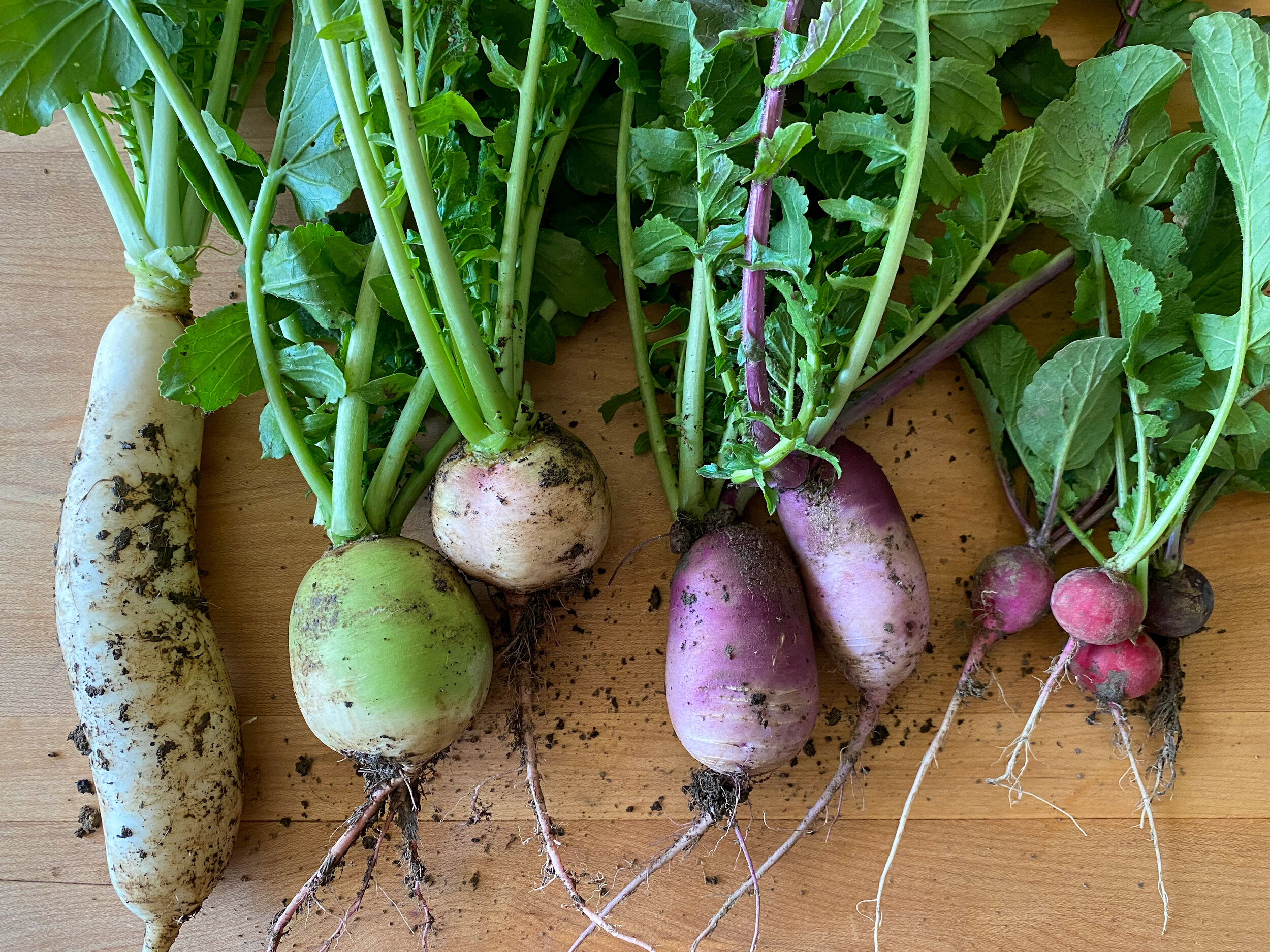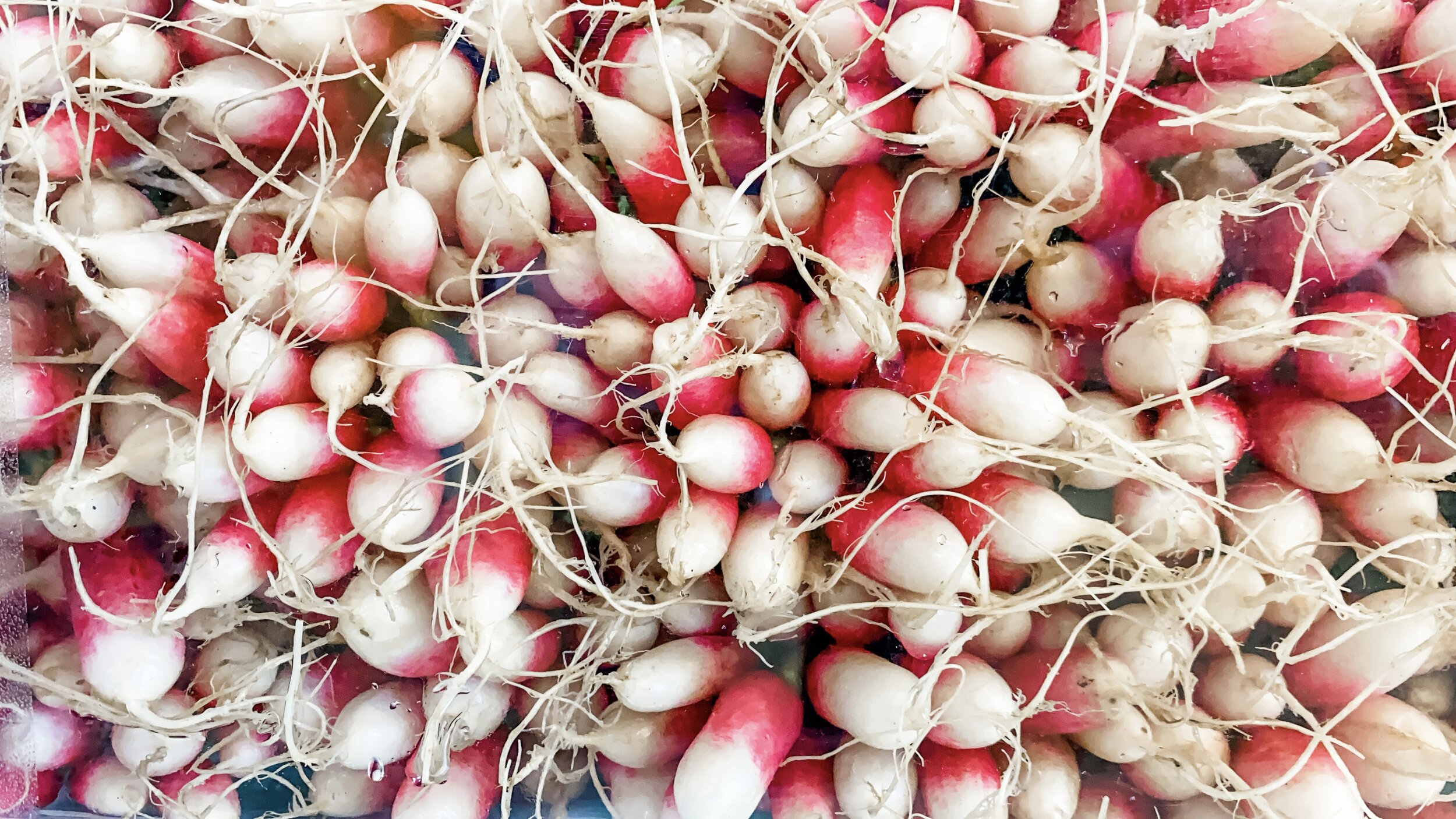Uncovering the Hidden World of Radishes
There’s a whole wide world of radishes out there to try, and no better person to guide you through it than Abby Lundrigan, our Crop Production Manager and devoted lover of this humble and highly underrated root vegetable:
Setting up the table one weekend at Findlay Market, it was made undeniably plain to me that I love radishes. The evidence was laid bare in front of me on the table: four—no, wait!—five different types of radishes. Later, a customer came up to me and pointed at each one:
“What’s this?”
“A radish.”
“And that one?”
“Also a radish.”
When he asked what the difference between each type was, I was glad for the opportunity, as I usually am, to expound on the very subtle but specific differences between each variety of radish.
One of my greatest joys in growing vegetables is the opportunity to demonstrate what tremendous variety exists beyond the singular type of a vegetable that we typically find in a grocery store. In a grocery store, you are likely to find the round, red salad radishes. They will be, in my opinion, far too large and have sad-looking greens that you would not even consider eating. If you are lucky, you may also be able to find the standard white daikon radishes as well, usually with no greens at all.
Believe it or not, the four to six different varieties of radishes that we grow at Turner Farm are barely a sampling of what exists in the broader radish realm. A deep dive into the world of radishes reveals colors, shapes, sizes, flavors, and textures in astonishing variety.
The varieties below are what we are currently growing at Turner Farm. All of these radishes are suitable for eating raw, but can also be cooked in a variety of ways. By this time of year many of their greens are looking poorly from exposure to the elements, but early in the fall they have beautiful, crisp greens that are delicious cooked. The flavor is similar to turnip greens, but I find them to be more tender and needing to be only lightly cooked.
However you eat them, I invite you to venture outside of the ordinary and introduce yourself to a new radish. You may find a new favorite!
Salad Radish
Purple and red round radishes of the Bacchus and Red Rover variety are the most commonly recognized, standard salad radish type. They are meant to be eaten raw, but can also be roasted whole or halved. They become spongy or pithy at the center when allowed to grow too large, so we harvest them regularly to make sure they are the right size for the perfect crunchy texture.
Shunkyo and French Breakfast (D’avignon), on the other hand, are both slender, cylindrical salad radishes, also meant to be eaten raw. In my opinion, it is especially important that these types not be oversized. These are my favorite to eat whole...perhaps dipped in a nice butter and sprinkled with a bit of salt.
Daikon Radish
The most recognizable daikon radish is white and cylindrical, with a pointy root end, and we grow the Miyashige variety of it. Daikon are most commonly used as an ingredient in kimchi, but they can also be roasted, added to a stir fry, or eaten raw. One of my favorite preparations is shredding them and then sauteing with whatever seasonings you choose for a texture reminiscent of hash browns.
This year, we are also growing a less commonly known purple daikon radish variety, KN Bravo. It is squat, without the pointy end of a traditional daikon. The purple daikon have a brilliant color and excellent crunchy texture that is still tender, so I have been eating them raw in salads.
Watermelon Radish
Watermelon radishes are admittedly my least favorite, only because I prefer to eat radishes raw rather than cooked. The watermelon radish has a tougher exterior and a harder, less tender crunch than the other varieties we grow, so I most often eat it roasted. It also has more of the typical radish spice than our other fall radishes, which have their characteristic flavor but are milder. They are stunningly beautiful, with a white exterior and surprise bright red center. They keep their color fairly well even when cooked, and their unique appearance makes them a nice choice for a crudité platter.
— Abby Lundrigan, Crop Production Manager at Turner Farm
Find out which of these radishes are for sale in our Farm Market now at turnerfarm.org/market, and for more radish recipe ideas, head over to Bon Appetit for 47 Radish Recipes That Put the Rad Back in Radish.




